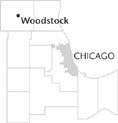| Entries |
| W |
|
Woodstock, IL
|
 McHenry County, 51 miles NW of the Loop. Woodstock was originally called Centerville toattract the seat of
McHenry County
government in 1842. The Centerville site was chosen instead of
Crystal Lake
or
McHenry
when Alvin Judd donated a two- acre public square for county offices. The square became the hub of a village plat recorded in 1844 by George Dean. In 1845, Woodstock adopted its current name after the Vermont birthplace of early settler Joel Johnson. Woodstock incorporated as a village in 1852 with Alvin Judd as president. The Greek revival–style courthouse that stands next to the square was built in 1857; it is now privately owned.
McHenry County, 51 miles NW of the Loop. Woodstock was originally called Centerville toattract the seat of
McHenry County
government in 1842. The Centerville site was chosen instead of
Crystal Lake
or
McHenry
when Alvin Judd donated a two- acre public square for county offices. The square became the hub of a village plat recorded in 1844 by George Dean. In 1845, Woodstock adopted its current name after the Vermont birthplace of early settler Joel Johnson. Woodstock incorporated as a village in 1852 with Alvin Judd as president. The Greek revival–style courthouse that stands next to the square was built in 1857; it is now privately owned.
In 1855 the Chicago & North Western Railroad passed through Woodstock. allowing farmers to send their dairy production quickly to Chicago. The Borden Company opened a dairy processing plant, one of the world's largest. The building is later became the home of the Claussen Pickle Company.
Because of increasing population following the Civil War, residents voted to give Woodstock city status in 1873, with John S. Wheat becoming mayor.
In January 1895, a federal court in Chicago sentenced Eugene V. Debs, president of the American Railway Union, to jail in Woodstock for his activity in the 1894 Pullman Strike. The square was filled with over 10,000 onlookers when he was released in November of the same year.
Woodstock's economic strength grew in 1896 when city officials donated empty factory buildings to Thomas Oliver for the manufacture of the noted Oliver Typewriter. In 1910, the Emerson Typewriter Company moved to Woodstock and began producing Woodstock typewriters. By 1922, about half the world's typewriters were made in Woodstock.
Besides the jail, built in 1887, a combined city hall, library, firehouse, and theater was built on the square in 1890. Jane Addams and Leo Tolstoy spoke in the building, known as the Woodstock Opera House, on different occasions. The theater was also used by students from the private Todd School for Boys in Woodstock, including the notable Orson Welles, who was a student between 1926 and 1931. Welles hinted at his experiences at the school and opera house in his 1946 movie The Stranger.
As the city vacated the opera house, the building became home to the Woodstock Players, a group that provided young graduates of Chicago's Goodman Theatre School with valuable professional experience in the late 1940s and early 1950s. Shelly Berman, Tom Bosley, Paul Newman, Geraldine Page, and Lois Nettleton performed regularly at the opera house, which is still in use after a major restoration in 1977.
Industrial activity generally declined in Woodstock after World War II. Yet, with reliable rail commuter transportation, the area became a destination for new residents fleeing Chicago's congestion. Residential construction boomed after the 1960s, bringing with it both economic prosperity and a lamented loss of a rural atmosphere. The revitalization of Woodstock's square, prominent in the 1993 movie Groundhog Day, displayed this growing prosperity. Population grew from 14,353 in 1990 to 20,151 a decade later.
| Woodstock, IL (inc. 1852) | |||||
| Year |
Total
(and by category) |
Foreign Born | Native with foreign parentage | Males per 100 females | |
| 1870 | 1,574 | 20.3% | — | — | |
| 1,563 | White (99.3%) | ||||
| 11 | Colored (0.7%) | ||||
| 1900 | 2,502 | 16.2% | 29.3% | 106 | |
| 2,496 | White (99.8%) | ||||
| 6 | Negro (0.2%) | ||||
| 1930 | 5,471 | 11.0% | 30.7% | 100 | |
| 5,451 | White (99.6%) | ||||
| 20 | Negro (0.4%) | ||||
| 1960 | 8,897 | 3.7% | 16.3% | 92 | |
| 8,881 | White (99.8%) | ||||
| 7 | Negro (0.1%) | ||||
| 9 | Other races (0.1%) | ||||
| 1990 | 14,353 | 6.9% | — | 94 | |
| 13,539 | White (94.3%) | ||||
| 81 | Black (0.6%) | ||||
| 6 | American Indian (0.0%) | ||||
| 201 | Asian/Pacific Islander (1.4%) | ||||
| 526 | Other race (3.7%) | ||||
| 1,067 | Hispanic Origin* (7.4%) | ||||
| 2000 | 20,151 | 16.9% | — | 101 | |
| 17,628 | White alone (87.5%) | ||||
| 214 | Black or African American alone (1.1%) | ||||
| 47 | American Indian and Alaska Native alone (0.2%) | ||||
| 406 | Asian alone (2.0%) | ||||
| 1,550 | Some other race alone (7.7%) | ||||
| 306 | Two or more races (1.5%) | ||||
| 3,830 | Hispanic or Latino* (19.0%) | ||||
The Encyclopedia of Chicago © 2004 The Newberry Library. All Rights Reserved. Portions are copyrighted by other institutions and individuals. Additional information on copyright and permissions.